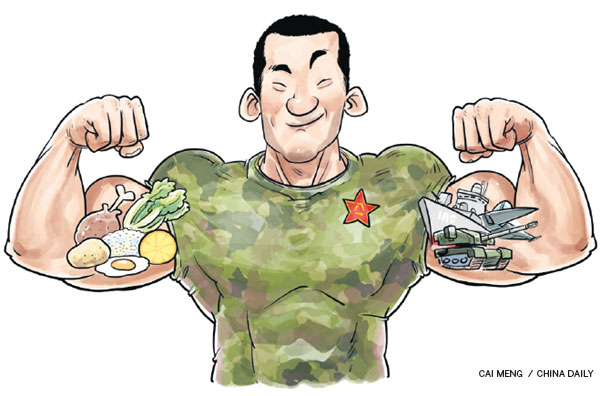PLA a past master at nutrition
By Zhang Zhouxiang (China Daily) Updated: 2017-08-01 07:42Editor's note: When the Red Army, the predecessor of the People's Liberation Army, was engaged in the revolutionary war in the 1930s, its soldiers got less than 1 penny a day to buy nonstaple food and firewood. Today the PLA offers its soldiers foods with balanced nutrition. In the past 90 years, the PLA has greatly improved the quality and nutrition level of the foods it serves. Two military experts share their views with China Daily's Zhang Zhouxiang. Excerpts follow:
Nutrition standards will improve further
The nutrition standards of a military are decided by two main factors: the importance its leadership attaches to nutrition, and the development level of the country.
Since the introduction of reform and opening-up policy in the late 1970s, the Central Military Commission has been paying greater attention to the nutrition standards of the foods PLA personnel get.
From 1978 to 2000, the PLA improved the nutrition standards mainly by raising the percentage of meat and vegetables in the personnel's diet to help them meet the needs of training and fighting.
Since 2000, the CMC has been focusing more on balanced nutrition. Over the past decade, the PLA has prepared different menus for officers and soldiers deployed at different posts to fully protect their health, and the ingredients for every dish are selected to ensure balanced nutrition. It has even introduced new posts called "diet nutritionists" to help design the best possible menus for soldiers and officers alike.
Of course, there is room for improvement. The PLA could follow the examples of developed countries' militaries and further diversify its menus, as well as make them more balanced. Thanks to China's growing prosperity and the central leadership's concern, the nutrition standards for PLA personnel will continue to improve.
Li Daguang, a researcher at the PLA National Defense University
A military marches on its stomach
The nutrition standards for PLA personnel are very high today compared with a few decades ago. The problem is no longer about providing personnel with nutritious food, but about how to deliver foods to soldiers and officers deployed at special posts in remote and hazardous places.
For example, Sansha city is more than 300 kilometers from South China's Hainan provincial coast, and the officers and soldiers stationed on the islands and reefs there depend on food shipments from Hainan and inland regions. And submarines have to carry enough foods to ensure the navy personnel manning them get enough to eat to be able to patrol the open seas for months at a stretch. In the Tibet and Xinjiang Uygur autonomous regions, where climate conditions can be treacherous, troops also get their food supplies from inland regions.
How to efficiently supply food to its personnel on such posts is a test for not only the PLA's supply system, but also for its combat capabilities.
The PLA has been doing quite well in this ongoing test. In Sansha, the PLA personnel get enough food supply to enjoy five dishes plus one soup for every meal. And submarines that patrol the seas often carry a wide variety of food to meet soldiers' needs.
A military marches on its stomach. By efficiently providing foods for its personnel on special posts in remote and hazardous places, the PLA is not only marching ahead but also improving its combat capability.
Zhang Junshe, a senior researcher at the PLA Naval Military Studies Research Institute

- 'Cooperation is complementary'
- Worldwide manhunt nets 50th fugitive
- China-Japan meet seeks cooperation
- Agency ensuring natural gas supply
- Global manhunt sees China catch its 50th fugitive
- Call for 'Red Boat Spirit' a noble goal, official says
- China 'open to world' of foreign talent
- Free trade studies agreed on as Li meets with Canadian PM Trudeau
- Emojis on austerity rules from top anti-graft authority go viral
- Xi: All aboard internet express











